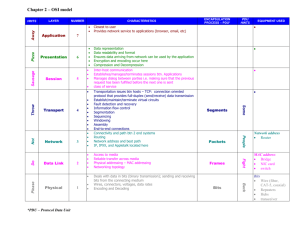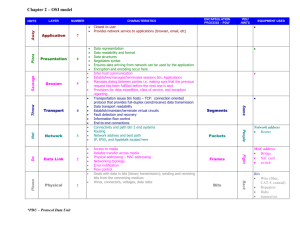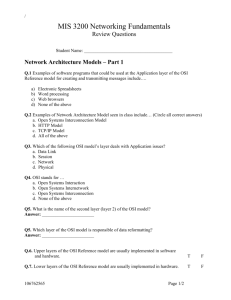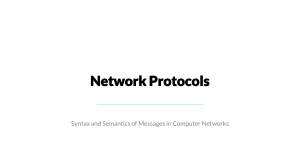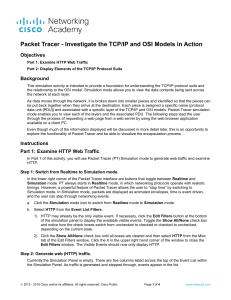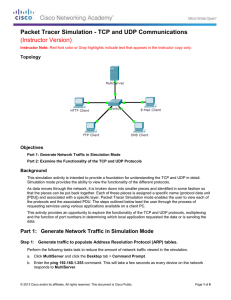Sistem Jaringan Komunikasi Data
advertisement
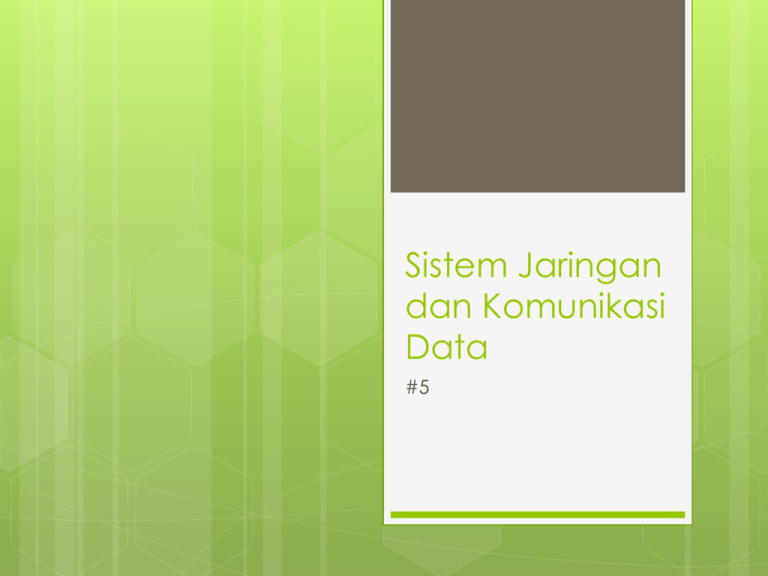
Sistem Jaringan dan Komunikasi Data #5 History Rapid growth of computer networks caused compatibility problems ISO recognized the problem and released the OSI model in 1984 OSI stands for Open Systems Interconnection and consists of 7 Layers The use of layers is designed to reduce complexity and make standardization easier 7 Layers of the OSI Model Layer 7.) Application 6.) Presentation 5.) Session 4.) Transport 3.) Network 2.) Data Link 1.) Physical Responsible For: Provides Services to User Apps Data Representation Communication Between Hosts Flow Ctrl, Error Detection/Correction End to End Delivery, Logical Addr Media Access Ctrl, Physical Addr Medium, Interfaces, Puts Bits on Med. Examples Layer Example 7.) Application HTTP, FTP, SMTP 6.) Presentation ASCII, JPEG, PGP 5.) Session BOOTP, NetBIOS, DHCP, DNS 4.) Transport TCP, UDP, SPX 3.) Network IP, IPX, ICMP 2.) Data Link Ethernet, Token Ring, Frame Relay 1.) Physical Bits, Interfaces, Hubs Mnemonics (A)ll 7.) (A)pplication (A)way (P)eople 6.) (P)resentation (P)izza (S)eem 5.) (S)ession (S)ausage (T)o 4.) (T)ransport (T)hrow (N)eed 3.) (N)etwork (N)ot (D)ata 2.) (D)ata Link (D)o (P)rocessing 1.) (P)hysical (P)lease Flat Addressing Flat addressing schemes do not provide anything other than a unique identifier. They provide no real information about where the object being addressed resides. Example: NIK# (may provide insight to where the person was registered, but not to where they are now) Hierarchical Addressing Hierarchical addressing schemes provide layers or a hierarchy to the address that provide information about where the addressed object exists within the hierarchy. Example: phone numbers (area code, local prefix, and four digit number unique to that area code/prefix combination). Talking to Everyone Special kinds of addresses exist at both layer #2 and #3 called broadcast addresses Typically network devices are interested in only traffic addressed directly for them and any traffic addressed with the destination address set to broadcast If they are paying attention to other traffic, they are said to be in promiscuous mode Encapsulation Data exists at each layer contained within a unit called a Protocol Data Unit (PDU). PDU’s are referred two ways: N-PDU, and by special names. The process by which data moves between PDU types is called Encapsulation PDU move through interfaces between layers using Service Access Points (SAP) PDU’s And the OSI Model Layer 7.) Application PDU Name Data 6.) Presentation Data 5.) Session Data 4.) Transport Segment 3.) Network Packet 2.) Data Link Frame 1.) Physical Bits Layer 1: The Physical Layer Defines physical medium and interfaces Determines how bits are represented Controls transmission rate & bit synchronization Controls transmission mode: simplex, halfduplex, & full duplex PDU: Bits Devices: hubs, cables, connectors, etc… Layer 2: The Data Link Layer PDU: Frames Keeps Link alive & provides connection for upper layer protocols Based on physical (flat) address space Physical addresses are fixed and don’t change when the node is moved Medium/media access control The Data Link Layer (cont.) Flow control and error detection/correction at the frame level. Topology Ex: Ethernet, Token Ring, ISDN Sublayers: MAC (framing, addressing, & MAC) & LLC (logical link control – gives error control & flow control) Devices: switches, bridges, NIC’s Layer 3: The Network Layer PDU: Packet End to end delivery of packets Creates logical paths Path determination (routing) Hides the lower layers making things hardware independent Uses logical hierarchical addresses The Network Layer (cont.) Logical hierarchical addresses do change when a node is moved to a new subnet Devices: routers, firewalls Layer 4: The Transport Layer PDU: Segment Service Point Address (more often called a port) used to track multiple sessions between the same systems. SPA’s are used to allow a node to offer more than one service (i.e. it could offer both mail and web services) This layer is why you have to specify TCP or UDP when dealing with TCP/IP The Transport Layer (cont.) Must reassemble segments into data using sequence numbers Can use either connectionless or connection oriented sessions Connectionless sessions rely on upper layer protocols for error control and are often used for faster less reliable links Ex: UDP (used by things like NFS & DNS) The Transport Layer (cont.) Connection oriented sessions require the sender to first request a connection, the receiver to acknowledge the connection, and that they negotiate how much data can be sent/received before its reception is acknowledged Uses acknowledgements & retransmission for error correction Example: TCP (used by things like telnet, http) Layer 5: The Session Layer PDU: Data (from here on up) Sometimes called the dialog controller, this layer establishes, maintains, and terminates sessions between applications Sets duplex between applications Defines checkpoints for acknowledgements during sessions between applications The Session Layer (cont.) Provides atomization – Multiple connections can be treated as one virtual session. If one fails or is terminated, all should be terminated. Identifies raw data as either application data or session control information Uses fields provided by layers 3 & 4 to track dialogs between applications / services Provides translations for naming services Ex: RPC, X-Windows, LDAP, NFS Layer 6: The Presentation Layer Data formatting, translation, encryption, and compression Ex: ASCII, EBCDIC, HTML, JPEG Layer 7: The Application Layer Provides communication services to applications Ex: HTTP, FTP, SMTP Address Resolution Two problems: #1 Layer 3 address resolution #2 Layer 3 to Layer 2 resolution IP vs IPX approaches Larger Example Scenario: subnets. sending a message between Source and Destination Layer 3 addresses don’t change Source and Destination Layer 2 addresses do How are addresses resolved? The Practical Benefits Of Understanding The OSI Model Helps with packet analysis Helps foresee problems Aides in network design (especially on large scale networks) Network Design & Admin Issues Examining network protocols and how they relate to the OSI model help aide network administers design networks and help admins troubleshoot strange behavior. If you don’t understand what mechanisms your network is using to communicate, you are more likely to introduce new problems while trying to fix old ones. TCP/IP Model Much older than OSI model Consists of 4 layers instead of 7 TCP/IP model can be mapped to the OSI model OSI Layers OSI v TCP/IP
